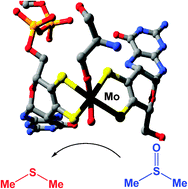Exploiting the versatility and selectivity of Mo enzymes with electrochemistry
Abstract
This article covers recent advances in the electrochemical study of the mononuclear

* Corresponding authors
a
Centre for Metals in Biology, School of Chemistry and Molecular Biosciences, University of Queensland, Brisbane 4072, Australia
E-mail:
p.bernhardt@uq.edu.au
This article covers recent advances in the electrochemical study of the mononuclear

 Please wait while we load your content...
Something went wrong. Try again?
Please wait while we load your content...
Something went wrong. Try again?
P. V. Bernhardt, Chem. Commun., 2011, 47, 1663 DOI: 10.1039/C0CC03681A
To request permission to reproduce material from this article, please go to the Copyright Clearance Center request page.
If you are an author contributing to an RSC publication, you do not need to request permission provided correct acknowledgement is given.
If you are the author of this article, you do not need to request permission to reproduce figures and diagrams provided correct acknowledgement is given. If you want to reproduce the whole article in a third-party publication (excluding your thesis/dissertation for which permission is not required) please go to the Copyright Clearance Center request page.
Read more about how to correctly acknowledge RSC content.
 Fetching data from CrossRef.
Fetching data from CrossRef.
This may take some time to load.
Loading related content
